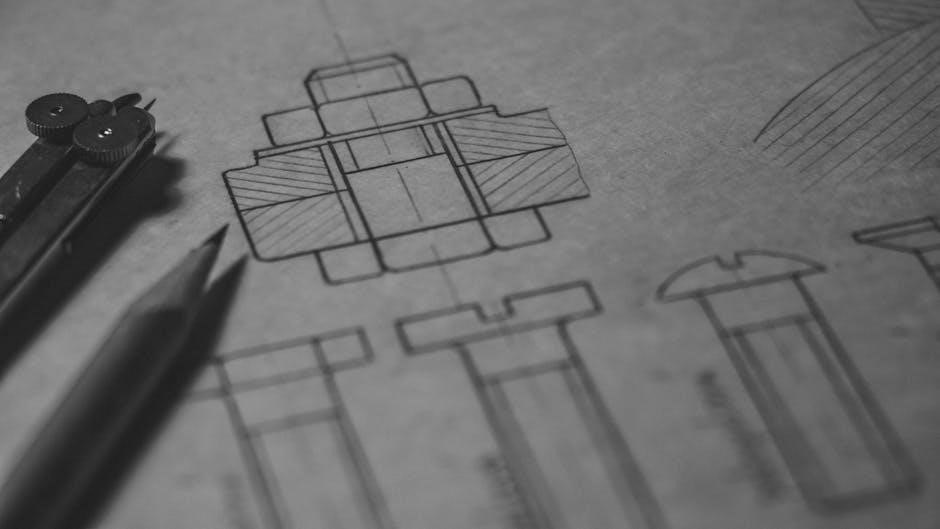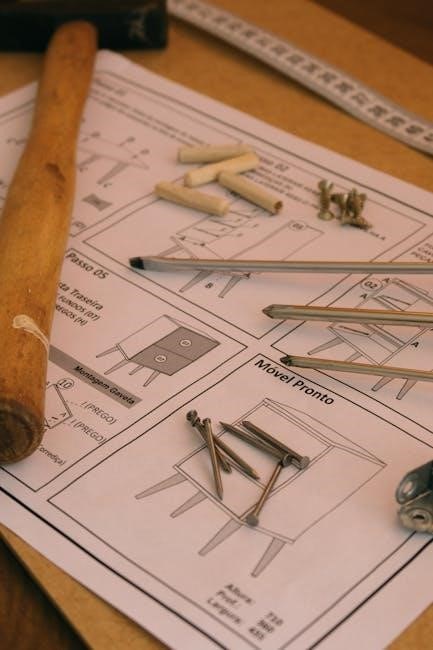Proper wheelchair measurements are crucial for ensuring comfort, mobility, and medical well-being. Accurate sizing prevents issues like pressure sores and enhances independence, making it a vital process for users.
1.1 Importance of Proper Wheelchair Fit
A proper wheelchair fit is essential for preventing medical issues like pressure sores and blood clots. It enhances comfort, supports posture, and boosts mobility. Correct measurements ensure the chair is neither too tight nor too loose, promoting stability and reducing the risk of falls. A well-fitted wheelchair also improves energy efficiency for manual users and maximizes independence, allowing users to navigate their environment with confidence and ease.
1.2 Overview of the Measurement Process
The measurement process involves assessing the user’s physical condition, seating needs, and mobility goals. Key measurements include seat width, depth, backrest height, armrest length, and footrest position. Proper posture and support are ensured by accurately measuring the user’s body dimensions. This process helps prevent medical issues like pressure sores and enhances comfort, stability, and mobility. Accurate measurements are crucial for selecting the right wheelchair, ensuring it fits well and meets the user’s specific requirements.

Key Measurements for Wheelchair Fitting
Accurate measurements ensure proper fit and comfort. Key areas include seat width, depth, backrest height, armrest length, and footrest position, all crucial for optimal support and mobility.
2.1 Seat Width and Depth
Seat width is measured from hip to hip or knee to knee, ensuring comfort and ease of movement. Depth is measured from the back of the knee to the buttocks. Proper sizing prevents pressure sores and ensures optimal posture. Standard widths range from 16 to 20 inches for adults, while depth typically ranges from 16 to 18 inches. Accurate measurements ensure the chair fits the user’s body, promoting comfort and mobility while avoiding discomfort or restricted movement. Proper fit is essential for long-term health and independence.
2.2 Backrest Height and Angle
The backrest height and angle are critical for proper posture and comfort. Height is measured from the elbow to the top of the seat cushion, ensuring shoulders remain relaxed. The angle should support the natural curve of the spine, typically between 90° and 110°. Proper adjustments prevent slouching and pressure sores, while also ensuring optimal breathing and upper body mobility. Accurate measurements ensure the backrest aligns with the user’s needs, promoting long-term comfort and reducing the risk of discomfort or injury.
2.3 Armrest Height and Length
Armrest height and length are essential for comfort and support. Height is measured from the seat to the underside of the forearm, with elbows slightly bent. Length should allow the forearm to rest fully, preventing strain. Proper adjustments ensure shoulders remain relaxed, reducing pressure on the arms and shoulders. Correct measurements prevent nerve damage and improve posture, while also ensuring the user can maneuver the wheelchair comfortably without discomfort or fatigue over time.
2.4 Footrest and Legrest Adjustments
Footrest and legrest adjustments are vital for comfort and mobility. The footrest height should align with the seat, supporting the feet without pressure. Legrest length and angle should accommodate the user’s leg length, promoting blood flow. Proper adjustments prevent discomfort, swelling, and strain, ensuring optimal support while allowing easy movement. Correct positioning enhances overall wheelchair fit and user satisfaction, making it essential for daily use and long-term health.

Tools and Equipment Needed for Measurements
Measuring tapes, calipers, protractors, and seating assessment tools are essential for accurate wheelchair measurements. These tools ensure proper fit, comfort, and functionality, making them indispensable.
3.1 Measuring Tapes and Calipers
Measuring tapes and calipers are fundamental tools for assessing seat width, depth, and backrest height. They ensure precise measurements, which are critical for a proper fit. These tools help determine the user’s anatomical dimensions, such as hip and shoulder width, to prevent discomfort or medical issues like pressure sores. Calipers are especially useful for precise body measurements, while tapes provide flexibility for various body types and postures, ensuring accuracy and comfort in wheelchair fitting.
3.2 Protractors for Angle Measurements
Protractors are essential for measuring angles, such as seat tilt and backrest angle, ensuring proper posture and comfort. Accurate angle measurements prevent discomfort or pressure issues. They help determine the optimal alignment of the wheelchair’s components, such as the footrest and armrest angles, to support the user’s specific needs. Using a protractor ensures precise adjustments, making the wheelchair more functional and comfortable for daily use, and it is a critical step in the fitting process for all users.
3.3 Seating Assessment Tools
Seating assessment tools are crucial for evaluating a user’s posture, pressure distribution, and comfort. These tools include pressure mapping systems and seat templates to ensure proper fit. They help identify potential issues like uneven weight distribution, which can lead to discomfort or medical complications. By using these tools, professionals can customize the seating to meet individual needs, providing optimal support and preventing long-term health issues. This step ensures the wheelchair is tailored for both functionality and well-being, making it indispensable in the measurement process.
Preparing for Measurements
Preparing for measurements involves clearing the area, ensuring proper posture, and wearing suitable clothing. This setup guarantees accurate and reliable results for a perfect fit.
4.1 Ensuring Proper Posture
Ensuring proper posture during measurements is essential for accuracy. The individual should sit with their head upright, shoulders relaxed, and pelvis in a neutral position. Feet should be flat on the floor or supported, avoiding any slouching or leaning. This posture helps determine the correct seat height, depth, and backrest alignment, ensuring optimal comfort and support. Proper posture also prevents potential medical issues like pressure sores and promotes better mobility and independence.
4.2 Clothing and Positioning
Wearing thin, form-fitting clothing is recommended during measurements to ensure accuracy. Loose or bulky clothes can distort results. Positioning is critical; the individual should sit naturally, as they would in daily use, with feet flat on the floor or supported. This ensures proper alignment and reflects their typical posture. Accurate positioning helps determine the correct dimensions for the wheelchair, promoting comfort and functionality. Proper clothing and positioning are essential for reliable measurements.
4.4 Clearing the Measurement Area
Ensuring a clear and unobstructed measurement area is vital for accurate results. Remove any obstacles or furniture that could interfere with the process. The floor should be level, and the space should allow the individual to sit comfortably without feeling cramped. A clutter-free environment ensures safety and ease of movement during measurements. This preparation step is essential for obtaining precise dimensions and ensuring the wheelchair fits perfectly. Clearing the area also helps the measurer access all necessary points efficiently.
Measuring for Manual Wheelchairs
Manual wheelchair measurements focus on seat width, depth, and backrest height to ensure optimal fit. Proper sizing enhances mobility and reduces strain during propulsion and use.
5.1 Lightweight and Folding Models
Lightweight and folding manual wheelchairs require precise measurements to balance portability and comfort. Seat width, depth, and backrest height are critical for optimal fit. Weight capacity and folding mechanisms should be considered to ensure durability and ease of transport. Proper alignment of the footrest and armrests is essential for user comfort and efficient propulsion. Measurements should also account for the user’s ability to maneuver the chair in tight spaces, ensuring both functionality and accessibility.
5.2 Rigid Frame Wheelchairs
Rigid frame wheelchairs, known for durability and efficiency, require specific measurements to enhance performance. The seat-to-floor height and backrest angle are critical for optimal propulsion. Weight distribution and frame alignment must be measured precisely to ensure stability and maneuverability. These chairs often feature adjustable components, so accurate measurements of the user’s body proportions are essential to maximize comfort and minimize strain during use, particularly for active users seeking high performance.
5.3 Specialized Manual Wheelchairs
Specialized manual wheelchairs are tailored for unique user needs, such as sports or outdoor use. Measurements focus on optimizing performance and comfort. The seat-to-floor height and wheel placement are critical for maneuverability. Angles and adjustable features must align with the user’s lifestyle and physical demands. Accurate measurements ensure proper fit, enhancing propulsion efficiency and reducing strain, while catering to specific requirements like additional support or customized angles for optimal posture and functionality. Precision is key to meeting individual preferences and performance goals.
Measuring for Power Wheelchairs
Measuring for power wheelchairs involves assessing weight capacity, seat dimensions, and control system placement. Proper fit ensures stability and ease of use, tailored to individual needs.
6.1 Weight Capacity and Stability
Weight capacity is critical for power wheelchairs to ensure safety and stability. The chair must support the user’s weight without compromising structural integrity. Stability is achieved by measuring the user’s weight and matching it to the chair’s specifications. Proper alignment of the axle and frame also enhances balance, preventing tipping. Ensure the chair’s weight limit is not exceeded to maintain optimal performance and user safety.
6.2 Seat and Backrest Adjustments
Seat and backrest adjustments are essential for optimal comfort and support in power wheelchairs. Measure seat depth to ensure proper thigh support without pressure points. Seat width should accommodate the user comfortably, allowing 1-2 inches of space on either side. Backrest height is measured from the elbow to the top of the seat cushion, ensuring shoulders remain relaxed. Adjustments should promote good posture, with optional cushions for additional lumbar or lateral support if needed.
6.3 Control System Placement
Control system placement is crucial for ease of use and accessibility. Measure the distance from the user’s body to ensure the joystick or controls are within easy reach. The display screen should be at eye level to avoid neck strain. Adjustments may include tilting or rotating the control panel for optimal comfort. Programmable settings can further customize the system to the user’s preferences, ensuring intuitive operation and reducing fatigue during use.
Measuring for Pediatric Wheelchairs
Pediatric wheelchairs require measurements accommodating growth, ensuring safety, and offering adjustability. Proper fitting supports posture and mobility, with features like seat depth adjustments and sturdy frames for stability.
7.1 Growth Accommodation
Growth accommodation is critical for pediatric wheelchairs, ensuring the chair adapts as the child grows. Measurements should account for future height and weight increases, typically by adding 1-2 inches to seat depth and width. Adjustable frames and seat components allow for modifications, preventing frequent replacements; This approach supports long-term comfort, posture, and mobility, making it essential for children’s developmental needs and ensuring optimal fit over time.
7.2 Safety Features
Safety features in pediatric wheelchairs are essential to prevent accidents and ensure stability. Harnesses, anti-tip bars, and secure footrests are critical components. These features protect children during movement and transport. Additionally, ensuring the wheelchair’s weight capacity and structural integrity is vital. Proper measurements help in selecting a chair that meets both safety and comfort needs, providing peace of mind for caregivers and optimal support for the child.
7.3 Adjustability Options
Pediatric wheelchairs often include adjustable features to accommodate growth and changing needs. Seat depth, height, and backrest angles can be modified to ensure proper support as the child grows. Adjustable footrests and armrests also contribute to comfort and posture. These options are crucial for long-term use, preventing the need for frequent replacements. Proper adjustments ensure the chair remains safe and supportive, promoting independence and comfort for the child. Regular assessments are recommended to update measurements and maintain optimal fit.

Measuring for Custom Wheelchairs
Custom wheelchairs require precise body mapping and detailed measurements to ensure optimal support and comfort. This process involves advanced tools and techniques to accommodate unique user needs.
8.1 Body Mapping and Contouring
Body mapping involves creating a detailed outline of the user’s body to design a customized wheelchair. This process ensures the chair contours to the user’s shape, providing optimal support and pressure distribution. Advanced tools like 3D scanners are often used to capture precise measurements, while manual methods involve tracing the body’s silhouette. Proper contouring enhances comfort, prevents sores, and promotes better posture, making it essential for long-term mobility and health.
8.2 Advanced Seating Solutions
Advanced seating solutions are tailored to meet specific user needs, ensuring optimal comfort and support. These solutions often include adjustable cushioning, lumbar support, and pressure-redistributing materials. They are particularly beneficial for users with complex postural requirements. By addressing individual needs, advanced seating enhances mobility, reduces the risk of pressure sores, and promotes long-term comfort. Collaboration with healthcare professionals ensures these solutions are both functional and aligned with the user’s lifestyle and medical requirements.
8.3 Bespoke Features
Bespoke features in custom wheelchairs allow for personalized adjustments to meet unique user preferences and lifestyles. These include specialized cushioning, adjustable armrests, and tailored footrests. Aesthetic options, such as color and style, also fall under bespoke features, enabling users to express their individuality. These customizations enhance comfort, functionality, and confidence, making the wheelchair an extension of the user’s personal identity while addressing specific physical and mobility needs.

Common Measurement Mistakes
Incorrect posture, ignoring weight, and overlooking adjustability needs are frequent errors. These oversights can lead to discomfort, reduced mobility, and even medical issues, emphasizing the need for careful assessment and expertise.
9.1 Incorrect Posture During Measurements
Incorrect posture during measurements can lead to inaccurate sizing, causing discomfort and reduced mobility. Slouching or leaning forward alters natural body alignment, affecting seat and backrest measurements. Tense shoulder muscles may result in incorrect armrest height assessments. Ensuring a neutral spine and relaxed posture is essential for precise fitting; Neglecting this step can lead to pressure points, poor support, and increased risk of medical issues like pressure sores or blood clots, emphasizing the importance of proper assessment techniques.
9.2 Ignoring Weight and Body Type
Ignoring weight and body type during measurements can compromise wheelchair stability and comfort. Exceeding weight capacity risks structural integrity, while body type influences support needs. Larger users may require wider seats, while petite users need proper proportions to avoid pressure points. Overlooking these factors can lead to instability, discomfort, or even medical issues. Tailoring measurements to individual body types and weight ensures optimal fit and functionality, promoting long-term mobility and health. Professional assessment is crucial to address these specific needs accurately.
9.3 Overlooking Adjustability Needs
Overlooking adjustability needs is a common mistake that can lead to discomfort and limited mobility. Wheelchairs must accommodate growth in pediatric cases or adapt to changing physical conditions in adults. Ignoring these factors can result in ill-fitting chairs, causing discomfort, pressure sores, or even mobility challenges. Adjustability ensures long-term usability, making it essential to consider during measurements. Regular assessments and customizable features help address these needs effectively, promoting optimal comfort and functionality for users of all ages and abilities.

Additional Considerations
Weight capacity, durability, and portability are essential for long-term usability. Aesthetics and user preferences also play a role in satisfaction, ensuring the wheelchair meets both practical and personal needs.
10.1 Weight Capacity and Durability
Weight capacity and durability are critical for ensuring a wheelchair’s safety and longevity. Always verify the maximum weight limit to prevent structural compromise. Durable materials, such as stainless steel or aluminum, enhance resilience. Consider the user’s lifestyle and mobility needs when selecting a frame type. Regular maintenance, like checking bolts and tires, extends the wheelchair’s lifespan. Prioritizing these factors ensures reliable performance and user confidence over time. Proper assessment prevents potential risks and guarantees optimal functionality.
10.2 Portability and Transport Needs
Portability and transport needs are essential for users who frequently travel or require easy storage. A lightweight frame or foldable design can significantly enhance mobility. Consider the frequency of transportation and the method used, whether by car, plane, or manual lifting. Ensure the wheelchair’s weight and dimensions align with these requirements; Additionally, assess the user’s ability to manage the chair during transport. Striking a balance between portability and stability ensures both convenience and safety. Proper planning helps users maintain independence and ease of movement in various settings.
10.3 Aesthetics and User Preference
Aesthetics and user preference play a significant role in wheelchair selection. Colors, designs, and customizable features can enhance confidence and satisfaction. Consider the user’s lifestyle, personal style, and preferences when choosing a wheelchair. For example, vibrant colors or sleek frames may appeal to some, while others prioritize understated designs. User feedback and involvement in the selection process ensure the wheelchair aligns with their identity and needs, fostering a positive experience and improved quality of life.
Resources and Tools
Utilize online guides, professional assessments, and measurement apps to ensure accurate wheelchair sizing. These tools provide comprehensive support for selecting the right chair, enhancing comfort and usability.
11.1 Online Measurement Guides
Online measurement guides provide step-by-step instructions for determining the correct wheelchair size. They often include video tutorials, downloadable templates, and interactive tools to help users accurately measure their body dimensions. These resources cover essential aspects such as seat width, backrest height, and armrest length. Many guides also offer tips for proper posture and positioning. By following these guides, users can ensure a comfortable and functional fit, whether for manual, power, or pediatric wheelchairs. They are accessible and user-friendly, making the measurement process straightforward for all.
11.2 Professional Assessment Services
Professional assessment services offer expert evaluations to determine the most suitable wheelchair for individual needs. Trained specialists use advanced tools to measure body dimensions and assess physical capabilities. These services often include personalized recommendations and ensure proper fit and functionality. Many programs also provide follow-up support to adapt to changing needs. Professional assessments are particularly beneficial for complex cases, ensuring optimal comfort, mobility, and medical well-being. They are widely available through healthcare providers and specialized mobility centers.
11.3 Measurement Apps and Software
Measurement apps and software are innovative tools that aid in determining the ideal wheelchair dimensions. These digital solutions use body measurements and posture assessments to recommend suitable sizes. They often include features like 3D modeling and real-time adjustments. While these tools enhance accuracy, professional oversight is still recommended for complex needs. Popular apps also offer guides for manual measurements, ensuring users can input data correctly. This technology bridges the gap between self-assessment and expert fittings, making the process more accessible and efficient for all users.
Accurate wheelchair measurements ensure optimal comfort, mobility, and health. By following guidelines and using proper tools, users can achieve the best fit, enhancing their overall quality of life.
12.1 Summary of Key Points
Proper wheelchair measurements ensure comfort, mobility, and medical well-being. Key points include accurate seat width, backrest height, and weight capacity assessments. Tools like measuring tapes and protractors are essential. Consider posture, clothing, and adjustability needs. Avoid mistakes like incorrect posture or ignoring weight. Additional factors include portability, aesthetics, and growth accommodation for pediatric users. Regular assessments and professional guidance are recommended for optimal fit, ensuring independence and quality of life for users of all ages and abilities.
12.2 Final Tips for Success
Accurate measurements and regular assessments are key to a well-fitting wheelchair. Use tools like measuring tapes and protractors to ensure precision. Consider posture, weight, and lifestyle needs. Consult professionals for complex cases and explore custom solutions. Prioritize comfort, stability, and adjustability to enhance mobility and independence. By following these steps, users can achieve optimal fit, reducing risks of discomfort and medical issues while improving overall well-being and quality of life.
